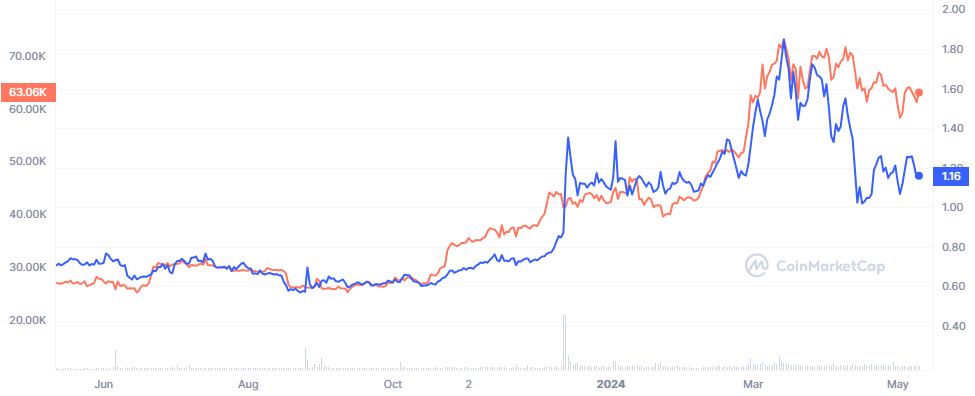The Nano project is once again trying to regain the spotlight by adding Web3 features and trying to stand out as a gaming platform. Nano was one of the projects to appear during the bull market of 2017 and 2018, promising to become the digital money of the future. The token went through several booms and busts, finally rebranding itself with a new ticker, XNO.
During the 2024 market expansion, XNO closely tracked Bitcoin’s growth, but so far, XNO has remained unchanged in Satoshi’s terms.

XNO established a new price range in 2024, trading up to a yearly peak of $1.60. Later, XNO took a step back and consolidated at $1.16.
As a payment tool, Nano was almost instant and extremely cheap to use. The coin relied on turning every mobile wallet into a node, propagating transactions with high speed and security. But the Nano project also suffered after the hack of the BitGrail exchange, where it crashed during the 2018 crypto winter.
Nano Tries to Attract Sustainable Web3 Games
The Nano network tries to find the right balance with Web3 gaming, which also offers earnings for the best performers. Play-to-earn games exploded in 2021, issuing millions of new tokens for all players. However, the model was not sustainable, and most games had to adapt or disappear.
Nano is trying to bring the next generation of games with more sustainable rewards for playing.
Instant, fee-free transactions with #nano go hand-in-hand with #gaming@wodoio knows this very well – The https://t.co/xJoVOC44Rj gamehub is now live!
— Nano (@nano) May 9, 2024
Earn up to Ӿ30 daily by playing the first FPS on the platform! 🎮
Dive in & start earning $XNO 👇https://t.co/zNRDFxkhYd
The XNO token itself will now become a reward, powering a new game ecosystem. Nano has retained a growing community over the years, though always facing the challenge of low token value.
What Changed for Nano After Surviving Two Bear Markets
Nano was formerly known as RAI Blocks, an attempt to reinvent global payments. The project always had grass-roots support and proved itself reliable as a way of sending value. Nano also gained support from the Litecoin community.
Since then, Nano turned to new use cases and applications. The goal is to make XNO usable for services and activities to build up organic demand in the long term.
1/ There is currently a shift happening in #nano and the $XNO community. This shift is setting nano apart from the rest of the #cryptocurrency space…
— Forest Ӿ (@ForestHorsman) May 9, 2024
What is this shift? Read it in my new article!https://t.co/jvKq5PKAcw
Too lazy to read? Check below for key takeaways 👇
One of the use cases is Nano GPT, where XNO is used to pay for premium prompts. Nano is perfectly adapted for microtransactions, due to its low latency and negligible fees. Microtransactions remove the need for subscriptions, giving access to several LLM.
The Nano network is also resistant to spam and may handle increased traffic linked to gaming or Web3 use cases. XNO microtransactions have also been applied to decentralized streaming. XNO has been paid out for filling out surveys or other micro-tasks. The advantage of XNO is that it fulfills the task of a token for small payments and rewards, without the need to use another blockchain.
On a usual day, the Nano blockchain is supported by around 122 online peers. Nano still has fewer than 500K wallets reported, but the network is capable of growing and scaling with each user. For now, Nano also has no central consensus server and has seldom reported lost coin balances.
Nano Returns to Faucet-Based Adoption
After years of spectacular runs and crashes, XNO may not guarantee a new hike to a higher range. XNO remains a low-value asset still trying to get back in the spotlight.
This also means XNO is accumulated and distributed to a wide community. Several faucet-like tools exist for Nano users, in the form of micro-payments or rewards for tasks and missions. During its initial distribution, XNO tokens were also distributed by a faucet that was open for more than a year before trading launched.
This time, Nano faucets can be created by anyone, giving out incentives through microtransactions. The sums from the faucets are small, but they can drive real activity tied to games or other reward mechanisms.
One of the setbacks of the Nano network is that it still has no decentralized finance. Even the Nano Swap exchange is practically illiquid. Nano also does not carry NFT or allow for other infrastructure tied to Web3. Instead, the XNO token uses its chief features – no fees and instant transfers – to become the basic unit of account for any type of project.
 cryptopolitan.com
cryptopolitan.com
